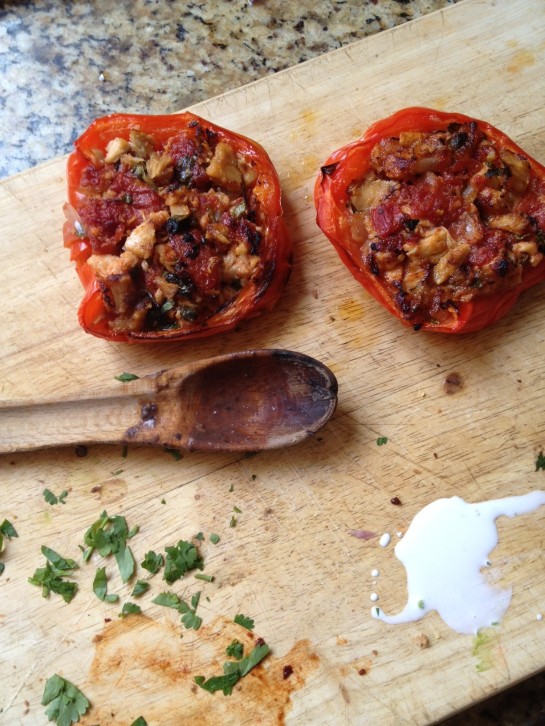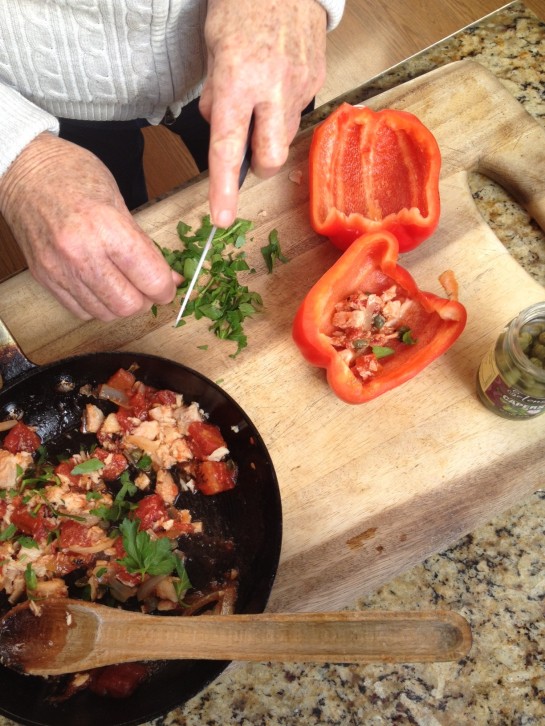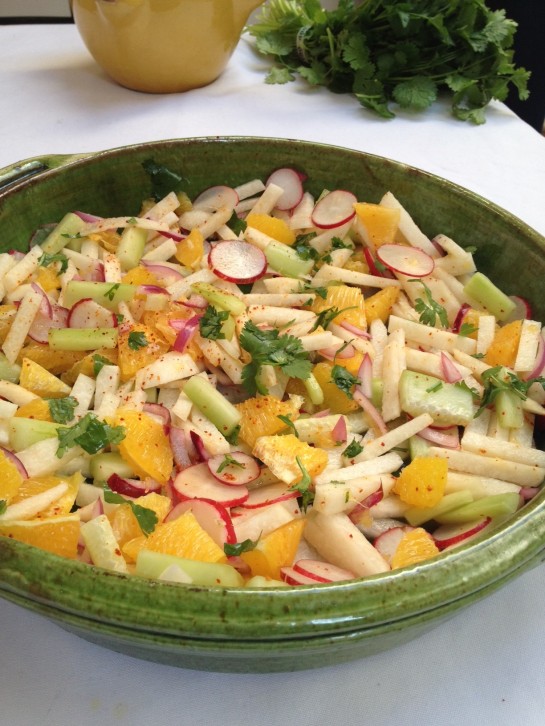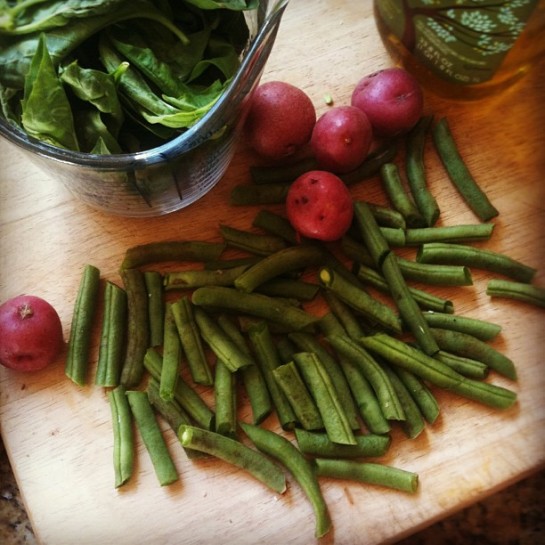January is the month that many of us are dismayed when we look in the mirror. So, hoping for a miracle, we seek out healthier food. I avoid the term “comfort” food because it brings to mind macaroni-cheese, mashed potatoes and that image in the mirror. So, what I’m aiming for are dishes that won’t necessarily knock off all those extra pounds but at least make a stab at “eating healthily” and, equally important, provide some delicious and different meals at the same time. Here are four vegetarian dishes of diverse origins – Italy, Catalonia, Mexico, and Provence. They don’t go together, but each is easy to make and won’t break the calorie bank.
Piedmontese Peppers
These are perfect for a light meal with – dare I say it – crusty bread to mop up the wonderful juices. Although it might be hard to find perfect tomatoes at this time of year, even less perfect ones will improve in flavor in their garlic-olive oil cocoon.
Serves 4 (2 halves per person)
Ingredients:
4 red peppers (these should be symmetrical, not deformed)
2 large garlic cloves, chopped
8 ripe plum tomatoes, skinned, halved and lightly salted
1/2 cup olive oil
1 can anchovy fillets
Preheat the oven to 350 degrees. Halve the peppers and remove the stem, core and seeds. Season each pepper half with salt and pepper and 1/8 of the garlic. Distribute the tomatoes evenly among the peppers, squishing them down a bit to almost fill the peppers. Place in a roasting pan and pour about a teaspoon of oil over each pepper, pouring any leftover oil into the pan. Bake for about an hour until the edges of the peppers are slightly blackened. Remove from the oven, let cool a bit, and distribute the anchovies evenly over the surface of the peppers. These are best served warm and are fine reheated the next day.
Postscript: After I had written this, I got to thinking about people who loathe anchovies and whether there was an alternative. So I sauteed a tablespoon of onion in olive oil, mixed it with about half a cup of canned tomatoes (I used Hunt’s fire roasted, diced, which I particularly like), half a can of drained and flaked tuna, a teaspoon of capers, a little garlic and salt and pepper. I stuffed two pepper halves with the mixture, doused them each with a teaspoon of olive oil and baked them in the same way. Here is Sam the Taster’s reaction: Delicious! I happen to love both anchovies and tuna, so I liked them both, but the peppers with anchovies definitely had more flavor…if you can’t stand anchovies, I suggest you mix the tuna well with the oil and capers and other ingredients so it absorbs as much flavor as possible.
Mushrooms, Green Beans, and Blue Cheese
We had this dish about 20 years ago in a popular restaurant in Barcelona called Señor Parrelada. It is still going strong, serving fine and reasonably-priced food. We have been making it ever since because it’s both unusual and delicious. The ingredients don’t seem intrinsically Catalan or even Spanish, but the original version was made with Cabrales, a strong blue cheese from the Asturias region in NW Spain. I use any good blue cheese that I have on hand. We serve this as a separate course or as an accompaniment to something fairly plainly cooked, like a steak, pork chop, or grilled chicken breast.
Serves 4
Ingredients
3/4 lb. green beans (preferably haricots verts, if available)
1/2 lb. mushrooms (white, brown or shiitake)
1 teaspoon olive oil or butter
2 oz. blue cheese, crumbled
Foil for baking
Preheat the oven to 350 degrees. Top, tail and halve the beans and cook them in boiling, salted water until still slightly crisp. The cooking time will depend on the size and quality of the beans. Slice the mushrooms into 3 or 4 pieces and saute them over fairly high heat in the oil or butter until lightly browned and almost cooked (3-4 minutes), adding a good pinch of salt on the way. Have ready a 12″x12″ piece of foil. Place the beans and mushrooms on the foil, season with pepper and a little more salt, and scatter half the cheese on top. Fold the foil over the mixture to make a secure package. Bake for 10 minutes until the cheese has melted and the beans and mushrooms are cooked to your liking. I say this because some people like their beans almost raw while we prefer them just barely crisp. Sprinkle with the rest of the cheese and serve, preferably still in its foil wrapper. The marvelous aroma as you open the package will send you to the moon.
Zucchini, Tomatoes, and Black Olives
I started making this years ago as a “low cal” dish during one of my periodic dieting binges. It is really versatile: You can make it with green and/or yellow zucchini (the smaller, the better), leave out the olives or add feta cheese. For a great pasta sauce just add a tablespoon of pesto. I usually make it adding the zucchini directly to the tomato sauce. However, if you sauté them first in a little oil until they brown lightly, it about halves the cooking time. Either way, it’s a delicious – and healthy – dish.
Serves 4
Ingredients
1 tablespoon olive oil
1 small onion, finely chopped
1 garlic clove
1 28-oz. can diced tomatoes (or 6 skinned and chopped tomatoes)
1 tablespoon chopped parsley or basil
4-6 zucchini, depending on size
12 black olives, pitted and halved
Slice the zucchini into thin (1/4″) rounds, salt lightly and let drain in a colander while you make a simple tomato sauce: Sauté the onion in the olive oil until softened, about 5 minutes. Add the garlic, well-diced tomatoes, salt and pepper and cook for a few minutes to combine. Pat the zucchini dry with paper towels and add to the tomato sauce. Cook until they are still a bit bitey – this will take about 20 minutes. Garnish with parsley or basil and the olives.
Jicama, Orange, Cucumber, and Radish Salad
This is adapted from Rick Bayless’s Mexican Kitchen. It’s so good that you won’t be able to stop eating it. Zero calories. Does this sound like a commercial? Make it and it’ll soon become a favorite.
Serves 4
Ingredients
1 medium jícama
1 cucumber
2 seedless oranges
6 radishes
1/3 cup lime juice
1 teaspoon chili powder
1 tablespoon chopped cilantro
Peel the jícama, cut it into 1/4-inch slices and then into batons about 1″ x 1/4″. Salt, and toss with half the lime juice and half the chili powder. Let it marinate while you prepare the rest of the ingredients. Peel the cucumber, cut it in half and scoop out the seeds if they’re well formed. Slice into half-moons,1/4 inch thick. Peel the orange and cut it into small segments, removing all the pith. Slice the radishes thinly. The aim of all this slicing and dicing is to make each bite fill your mouth with a balance of flavors so that none dominates.
Mix these ingredients together, adding the rest of the lime juice and the chili powder and more salt to taste. Sprinkle with the chopped cilantro and serve immediately. But don’t worry if the dish stands a while – the ingredients will weep a little making an even richer sauce.










